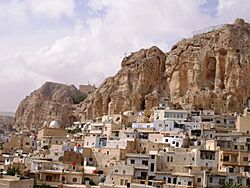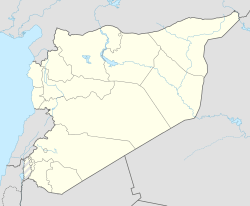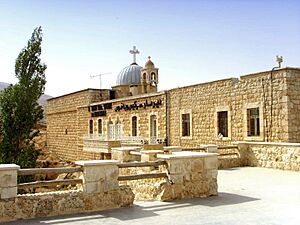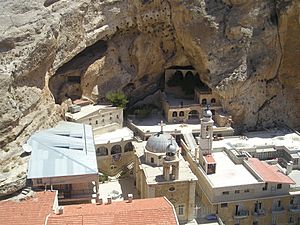Maaloula facts for kids
Quick facts for kids
Maaloula
ܡܥܠܘܠܐ
معلولا
|
|
|---|---|
|
Town
|
|

Overview of Maaloula, 2006
|
|
| Country | |
| Governorate | Rif Dimashq |
| District | al-Qutayfah |
| Subdistrict | Maaloula |
| Elevation | 1,500 m (4,900 ft) |
| Population
(2004 census)
|
|
| • Total | 2,762 |
Maaloula (Arabic: مَعلُولَا; Western Neo-Aramaic: ܡܥܠܘܠܐ ,מעלולא, romanized: Maʿlūlā) is a special town in Syria. It is built high up in the mountains, about 56 kilometers (35 miles) northeast of Damascus. Maaloula is famous because it is one of the last places where people still speak Western Neo-Aramaic. This is a very old language, similar to the one spoken by Jesus. There is only one other nearby village, Jubb'adin, where this language is still spoken.
Contents
Meaning of the Name Maaloula
The name Maʿlūlā comes from an old Aramaic word, maʿəlā. This word means "entrance" or "way in". You might see the name spelled in different ways, like Ma'loula or Maalula, but "Maaloula" is the most common.
Who Lives in Maaloula?
Long ago, in 1838, people in Maaloula belonged to different Christian groups and a small number of Muslims. Today, the town still has both Christians and Muslims. What's really interesting is that both groups see themselves as Arameans. Unlike most other people in Syria, the Muslims in Maaloula have kept their original identity. They did not become Arab over time.
About 50 years ago, around 15,000 people lived in Maaloula. In 2004, a count showed 2,762 people lived there. But in the summer, the population grows to about 10,000. Many people come from Damascus to enjoy their holidays in the town.
The Unique Language of Maaloula
Maaloula, along with the nearby villages of Jubb'adin and formerly Bakh'a, is the only place left where a Western Aramaic language is still spoken. This language has survived because the town is far from big cities and hidden by mountains.
However, modern roads, easy travel, and Arabic TV have slowly made it harder to keep the language alive. These three villages are very important for studying old languages. Experts believe that the language Jesus spoke was a type of Western Aramaic.
Ancient Monasteries
Maaloula is home to two very old and important monasteries: the Melkite monastery of Mar Sarkis and the Antiochan Convent of Saint Thecla.
Saint Sarkis Monastery
The Saint Sarkis Monastery is one of the oldest monasteries still standing in Syria. It was built on the site of an even older pagan temple. Some parts of the monastery date back to the 5th or 6th century.
Saint Sarkis is the Aramaic name for Sergius, a Roman soldier. He was killed because he believed in Christianity. This monastery still feels very old and historical. It also has two of the world's oldest religious paintings, including one showing the Last Supper.
Convent of Saint Thecla
This convent holds the remains of Thecla. She was a noble young woman and a student of Paul the Apostle in the 2nd century. A later story says that Thecla was running away from soldiers who wanted to capture her because of her Christian faith. She prayed, and the mountain opened up, letting her escape through a gap. Some people say the town's name, Maaloula (meaning "entrance"), comes from this story. However, people in Maaloula tell many different versions of this legend.
Other Holy Places
Maaloula also has the remains of many other monasteries, churches, and holy places. Some are in ruins, while others are still standing. Many people, both Muslims and Christians, visit Maaloula. They come to receive blessings and offer prayers.
Maaloula During the Syrian War
Maaloula became a place of fighting during the Syrian Civil War. In September 2013, a group called Al-Nusra Front fought against the Syrian Army there.
The Al-Nusra Front took control of the town on October 21, 2013. About 13 people were killed, and many more were hurt. On October 28, government forces took the town back.
However, the Al-Nusra Front took Maaloula again on December 3, 2013. This time, they took 12 Orthodox nuns as hostages. The nuns were moved around and held for three months in a place called Yabroud. Officials from Lebanon helped to make a deal for their release. As part of the deal, about 150 Syrian women held by the government were also set free. After the nuns were freed on March 9, 2014, they said that their captors mostly treated them well.
On April 14, 2014, the Syrian Army, with help from Hezbollah and the SSNP, took control of Maaloula once more. This was part of several wins for the government in the important Qalamoun region.
The Virgin Mary Statue
The people of Maaloula were very happy when a new statue of Mary, mother of Jesus was put up in the town center. The old statue had been destroyed during attacks in 2013. On June 13, 2015, Syrian officials showed the new statue of the Virgin Mary. She was wearing a white robe and a blue shawl, with her hands lifted in prayer. The statue was made of fiberglass and stood over 3 meters (10 feet) tall. It was placed on the base of the original statue.
This statue is called "Lady of Peace" (Arabic: سيدة السلام).
Images for kids
See also
 In Spanish: Malula para niños
In Spanish: Malula para niños








